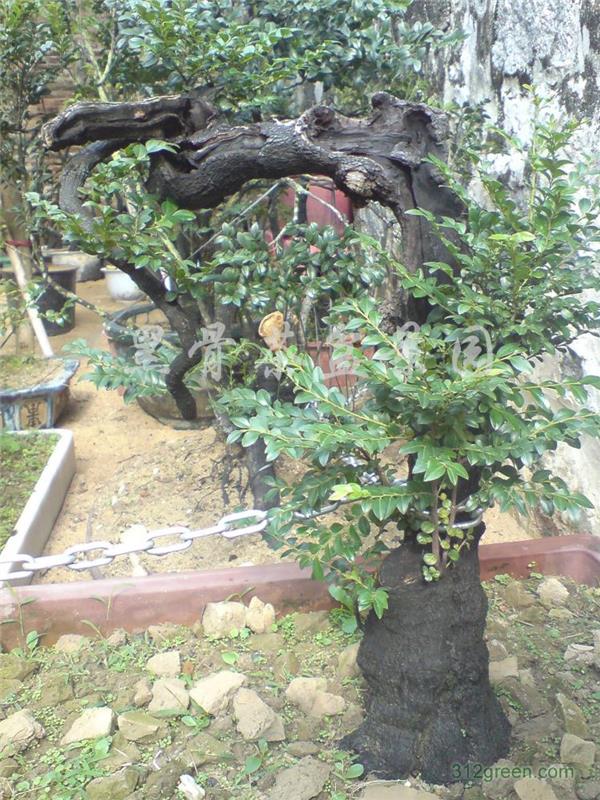Nursing method of black sandalwood bonsai culture
Many people like to raise bonsai, ebony bonsai is a very popular one, today the editor will introduce to you the breeding methods of ebony bonsai.
Black sandalwood alias black bone incense, red sandalwood, persimmon sandalwood genus. Leaves small, alternate, chicken heart-shaped, leathery, dark green, new bud leaves tender red. Shrubs. The bark and roots are black. The wood is hard. The growth rate is slow, the branch shape rises, mostly appears in the form of jungle or even root, and you can often encounter good jungle piles.

[breeding pile stage]
The growth of ebony bonsai is slow, and it is the slowest growing tree species in Lingnan bonsai, which is slower than that of boxwood. Therefore, in the selection of stakes, special attention should be paid to the selection of stumps with young branches. If the cut is more than 3 cm, it will be difficult to cultivate a matching branch support. The best mining time for ebony is after the Spring Equinox and before Grain in Beard. Black sandalwood has strong sprouting power and fast root, so the stem, care and root can basically be cut in place at one time. After the stump was cut off and soaked in water for 24 hours, it was planted with river sand, placed in a semi-shaded place to maintain dry body humidity, black liquid secretion could be seen at the section after 20 days, sprouting a few days later, and new roots could be seen in 60 days, and the survival rate was very high.

[management at the stage of branch accumulation]
1. After the ebony survives, it can be transferred to the ventilation place in Dangyang and apply light fertilizer and water to make the roots strong and strong. The Autumn Equinox can set the support according to the modeling needs, cut off all the unnecessary branches, and let the nutrients concentrate on the modeling branches. Black sandalwood roots after strong like fertilizer, can appropriately increase the proportion of fertilizer and water, water and fertilizer once every 7 days. The basin noodles apply rotten farm manure for a long time, so that the nutrients are slowly dissolved every time the water is drenched, which is beneficial to the absorption of the stump. The water should be dry and wet. If you don't do it, you will get drenched. Lesser Snow stopped fertilizing and completed the management of a growth cycle. It is worth noting that during the whole growth cycle, there should be no growth retardation due to the shortage of fertilizer and water. With this kind of management, the branch diameter can be cultivated to 0.6 mm in one growth cycle and 1.2 mm in two growth cycles, which can generally match the original pile support, that is, the first node can be obtained in two years.
two。 The ebony bonsai is evergreen all the year round, and new shoots sprout every season. Therefore, it can be cut in all seasons; each pruning can only be carried out after the new shoots are ripe, but it is better in spring and autumn. Black sandalwood bonsai is not easy to lose branches, can be pruned by a single branch, and leave strong buds, one master and one pair, and bend the buds with iron wire to make the branches go sideways. If the new buds are allowed to grow freely, they will all grow upward, and it is difficult to meet the requirements of spreading branches across the shoots. There are not many black sandalwood fibrous roots, but they can be replanted once every 5 years, even if the sandy soil is planted after 5 years, as long as sufficient farm manure is applied.
It's not too late. Repeat the management of the previous growth cycle every year until the work is basically formed.

[maintenance after forming]
After the ebony bonsai is formed, it enters the viewing period. To keep the work undeformed, the amount of fertilizer and water can be reduced to maintain the normal growth of the work. Remove the cluttered buds at any time. Strip and change brocade is carried out once a year before Qingming Festival, and the best viewing time is when the new buds spit red 30 days later. Black sandalwood bonsai is shade-resistant, put indoors after enough water, do not need to be drenched for 20 days, and soak again when the cement soil turns white. It can be placed indoors for 50 days and then return to the normal management outside. It is one of the longest indoor tree species in Lingnan bonsai. Black sandalwood has fewer diseases, only a small number of leaf rollers, which can be sprayed with 2/1000 Didi emulsion.

The above is the ebony bonsai decoration network.
Related
- Wuhan Hospital Iron Tree Blooming Result Was Instantly Frightened by the Gardener Master
- Which variety of camellia is the most fragrant and best? Which one do you like best?
- What is the small blue coat, the breeding methods and matters needing attention of the succulent plant
- Dormancy time and maintenance management of succulent plants during dormancy
- Minas succulent how to raise, Minas succulent plant pictures
- What are the varieties of winter succulent plants
- How to raise succulent plants in twelve rolls? let's take a look at some experience of breeding twelve rolls.
- Attention should be paid to water control for succulent plants during dormant period (winter and summer)
- Watering experience of twelve rolls of succulent plants
- Techniques for fertilizing succulent plants. An article will let you know how to fertilize succulent plants.



